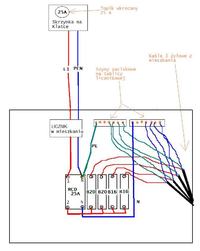Hello,
I am writing to you because today one thing started to interest me, namely.
In the block of flats (old building, post-German) I have a 2-core copper installation, at home I recently replaced the installation with a 3-core one and I do not know what to do with this new grounding cable, I read a lot of comments on the forum, which makes my head completely confused, no I also know what type of electrical network I have in the block ...
I mean exactly that once the zero wire bridged with the pin, (as I mentioned the installations in this apartment, several sockets also had the zero bridged with the pin)
And now the question arises, if you connect the neutral wire from the entrance to the apartment with the neutral wire and the grounding wire from the exit from the apartment, what will happen? because at first glance it seems that it will work in the same way as when bridging zero with a pin in each socket,
but you will not have to do it separately at each socket ...
I am asking for any statements without the type "leave it, you don't know each other, idiot etc. etc." because I just asked a question and I want to get an exact answer to it, if one of the users is able to answer and explain it, please, and if not, please do not post in this topic,
greetings
I am writing to you because today one thing started to interest me, namely.
In the block of flats (old building, post-German) I have a 2-core copper installation, at home I recently replaced the installation with a 3-core one and I do not know what to do with this new grounding cable, I read a lot of comments on the forum, which makes my head completely confused, no I also know what type of electrical network I have in the block ...
I mean exactly that once the zero wire bridged with the pin, (as I mentioned the installations in this apartment, several sockets also had the zero bridged with the pin)
And now the question arises, if you connect the neutral wire from the entrance to the apartment with the neutral wire and the grounding wire from the exit from the apartment, what will happen? because at first glance it seems that it will work in the same way as when bridging zero with a pin in each socket,
but you will not have to do it separately at each socket ...
I am asking for any statements without the type "leave it, you don't know each other, idiot etc. etc." because I just asked a question and I want to get an exact answer to it, if one of the users is able to answer and explain it, please, and if not, please do not post in this topic,
greetings



